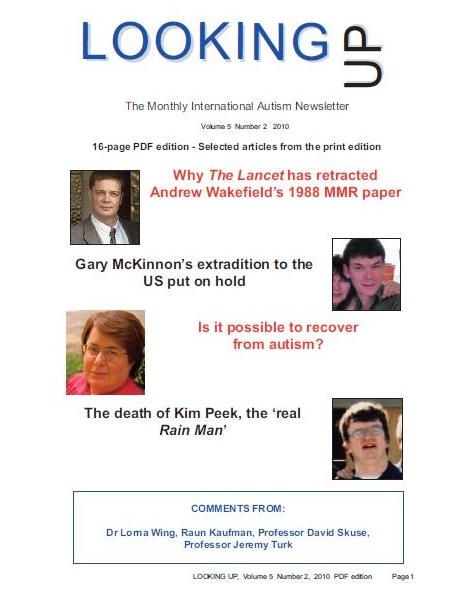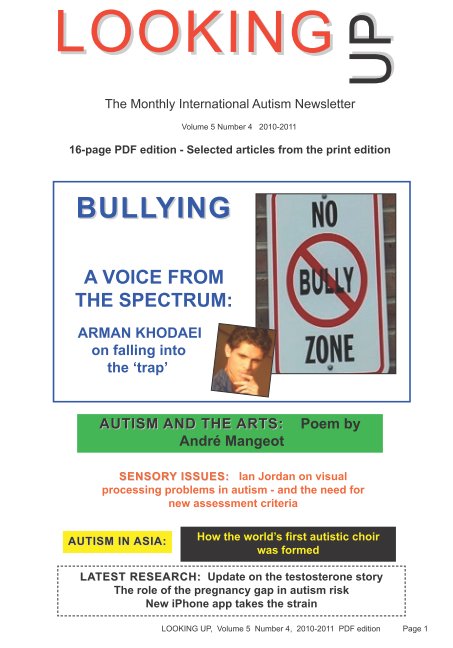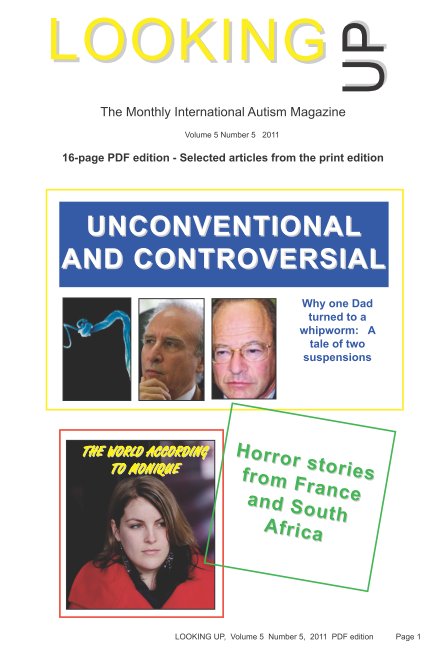Looking Up, 16-page English PDF Edition, Back Issues and Current Issue

|

|

|

|

|

|

|

|
| Home page | Subscribe (print edition) | Selected articles | Our publications | Our mailing lists |
| PDF edition | Subscribe (PDF edition) | Back issue contents | Autism books | Contact us |
From Volume 3 Number 12
NASHVILLE, Tennessee, USA: A single gene that appears to increase the risk of a person developing
autism when mutated has been identified by scientists, suggesting new
approaches to
diagnosing and treating the condition.
Research in the United States has
revealed that many cases of autism may be triggered in a similar
fashion to diseases such as cystic fibrosis — in which one gene goes
wrong, but in a multitude of different ways.
The work at Vanderbilt University
in Tennessee suggests that it may be possible to develop a blood test
that can pinpoint the probable cause, which could have important
implications for treatment.
It is known that some children and
adults with autism respond positively to a class of anti-depressant
drugs called selective serotonin reuptake inhibitors (SSRIs), which
includes Prozac and Seroxat.
Dr James Sutcliffe, a research
leader, said: "You might be able to predict which kids would respond
positively to particular SSRI medications."
The gene that has been implicated
in autism is the serotonin transporter gene, known as SERT. This plays
a key role in regulating the brain's levels of serotonin, a signalling
chemical involved in mood, impulsive behaviour and sleep.
Scientists have known for some
time that about 25 per cent of people with autism have elevated levels
of serotonin in their blood, suggesting a possible link to the
disorder.
In the August 2005 issue of the
American Journal of Human Genetics, Dr Sutcliffe, Dr Randy Blakely and
colleagues report that several mutations within the serotonin
transporter (SERT) gene, which regulates serotonin levels in the brain,
may be risk factors for autism …
To read the entire article you need to order this back issue

|

|

|

|

|

|

|

|
| Current 40-page print edition issue | |||||||||||||||
|---|---|---|---|---|---|---|---|---|---|---|---|---|---|---|---|

|
| ||||||||||||||
| PRINT EDITION BACK ISSUE CONTENTS AND FRONT COVERS | ||||||||||||||||||||||||||
|---|---|---|---|---|---|---|---|---|---|---|---|---|---|---|---|---|---|---|---|---|---|---|---|---|---|---|
| VOLUME 1, Number: | 1 | 2 | 3 | 4 | 5 | 6 | 7 | 8 | 9 | 10 | 11 | 12 | VOLUME 2, Number: | 1 | 2 | 3 | 4 | 5 | 6 | 7 | 8 | 9 | 10 | 11 | 12 | |
| VOLUME 3, Number: | 1 | 2 | 3 | 4 | 5 | 6 | 7 | 8 | 9 | 10 | 11 | 12 | VOLUME 4, Number: | 1 | 2 | 3 | 4 | 5 | 6 | 7 | 8 | 9 | 10 | 11 | 12 | |
| VOLUME 5, Number: | 1 | 2 | 3 | 4 | 5 | 6 | 7 | 8 | ||||||||||||||||||
| You can find our PDF EDITION CONTENTS AND COVERS on our PDF EDITION BACK ISSUES PAGE | ||||||||||||||||||||||||||
| Home page | Subscribe (print edition) | Selected articles | Our publications | Our mailing lists |
| PDF edition | Subscribe (PDF edition) | Back issue contents | Autism books | Contact us |